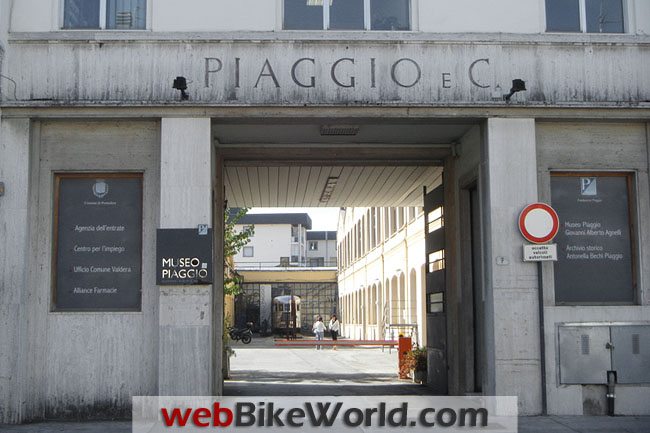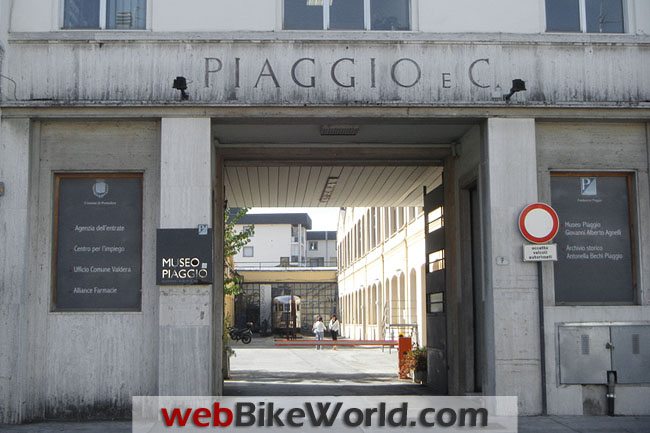Una visita al Museo Piaggio A Visit to the Piaggio Museum
Unlike nearby Florence with its art, or Pisa with its tower, the industrial town of Pontedera in northwestern Italy isn’t an obvious sightseeing destination.
In recent years, however, there has been an increasing influx of pilgrims — scooter pilgrims, journeying to the shrine of Vespa.
Parent company Piaggio has been making scooters in Pontedera since the first Vespa was built in 1946 and in 2000.
Some of the factory buildings were repurposed as a museum and archive.
The town is proud of its most famous export.
There’s a sculpture in the distinctive shape of Vespa’s monocoque shell outside the train station, while a water tower painted with the Piaggio logo is visible as soon as you arrive.
The museum itself is a blocky, imposing building in yellow stone.
The first things you see when you walk through the gate are, oddly, an aeroplane and a train.
Piaggio started out as a manufacturer of locomotives, with aeroplanes following during WWI (Piaggio Aero split off from its parent company in the 1960s and is still producing aircraft today).
The distinctive curves and metal skins of the vehicles on display echo the design ethos of the more familiar scooters.
Once inside, the focus switches to scooters straight away. First, one must pass through the Archivo Storico Piaggio, a corridor lined with box files.
Glass cases down the centre display photographs, letters and other documents from Piaggio’s history along an historical timeline.
The main attraction though is the central hall — a vast space filled with vehicles.
On entering, you might be forgiven for emitting a small squeal as you wonder where to go and what to look at first.
There are old Vespas, modern Vespas, racing Vespas, Vespas decorated by fashion designers and even a Vespa autogyro.

There’s a military version toting an anti-tank weapon (really!) and a giant Vespa built as a publicity prop.
I’m especially fond of the Piaggio Ape (pronounced AH-pehy), the Italian word for ‘bee’, as opposed to Vespa, the wasp.
The Ape is the funny little three-wheeled van which is still an ubiquitous workhorse in Italy and on which Valentino Rossi cut his teeth.I
In addition to the Piaggio and Vespa vehicles there’s a sizeable collection from Gilera, a brand acquired by the Piaggio Group in 1969. These are sports machines, decked out in Gilera’s red and black livery and dating back to 1909.
There are also many displays of vintage advertising posters and newspaper cuttings.
Looking at these, it’s apparent what a chic, cult brand Vespa has always been and how great an effect these little scooters have had on the three worlds of motorcycling, art and fashion.
The smiles on the faces of the other visitors as they exclaim delight and take photographs clearly show the affection in which the brand is held.
An example of the dedication of Piaggio fans were the two heavily-laden Vespas with Austrian plates which were parked outside the museum.
The visitors’ book tells the same story.
Tourists from as far afield as Russia and the USA, Sweden and Japan have taken the time to reminisce about their own cherished machines, draw pictures or affix their scooter club stickers to the pages.
The message I saw over and over again was ‘Thank you’.
Piaggio Museum Slide Show
Planning Your Visit
Pontedera is an unremarkable but pleasant town with a pedestrian-friendly square at its heart and plenty of places to eat, drink and stay.
Most visitors are here on business and the hotels are geared to that. We spent two nights at the three-star La Rotonda, where the staff couldn’t do enough for us.
The museum is an easy walk from the town centre. It isn’t huge, but if you want to look at everything properly — and you will — it can easily take up half a day.
There’s no cafe, but there are vending machine for drinks and snacks.
The exhibits are largely on one open-plan floor.
Space between the displays and wide doors make wheelchair access easy. However, the small balcony where most of the Gilera models are housed can only be reached by a flight of stairs.
Most of the products in the gift shop can also be purchased at your local Piaggio dealer.
I wanted something that told the world I had visited the museum, so I went for a Museo Piaggio keyring which now hangs proudly from the ignition of my Vespa.
You can also find some postcards in Pontedera’s tourist information office.
If you’re touring Tuscany, which boasts gorgeous countryside and plenty of cultural attractions, stop off in Pontedera and pay homage to the Vespa.
As uniquely Italian as the Leaning Tower of Pisa and as much a masterpiece as the Mona Lisa.
For More Information
Museo Piaggio
‘Giovanni Alberto Agnelli’ viale Rinaldo Piaggio 7
56025 Pontedera, Italy
Opening hours: Tuesday to Saturday, 10:00 to 18:00
Entry: Free
Owner Comments and Feedback
See details on submitting comments.
Other WebBikeWorld News Posts









